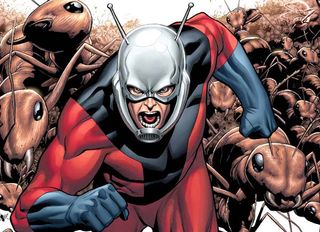How Strong Would A Human Sized Ant Be
Why Aren't Insects Human-Size?

The Ant-Human being cometh.
Director Edgar Wright, known for movies such as "Shaun of the Expressionless," announced before this week he would be making a movie about Ant-Man, a comic superhero who can shrink to the size of an ant and communicate with his formic brethren, co-ordinate to the news site Grantland. If it's annihilation like the comic, it volition likewise feature ants as large as humans, which got united states thinking: Could ants exist as big as people? And why aren't insects bigger than they are?
The curt respond is, researchers don't know exactly, although at that place are several hypotheses as to why insects and other arthropods don't go bigger, said insect physiologist Jon Harrison, at Arizona State University in Tempe.
The first hypothesis is that insects' exoskeletons may not exist stiff enough to allow them to get much bigger — that they'd have to become impossibly thick. Harrison learned this theory every bit an established fact during his training, but piffling experimental prove to support the thought exists, he said. The just written report to look at this question found that larger arthropods don't have thicker exoskeletons, he said. "So in that location's no direct prove for this," he said.
Too tasty
Because exoskeletons are rigid, insects demand to molt every bit they abound, shedding the former skin and growing a new i. Scientists have suggested this vulnerable time puts a ceiling on size: Larger animals, particularly those without protective skeletons, would brand for more than attractive meals to a predator. "The bigger you get, the more of a tasty vulnerable packet you are," goes the thinking, Harrison said.
A related theory suggests existence larger makes you a more than bonny repast, whether molting or not. I study constitute that the size of ancient flies declined equally birds evolved, suggesting smaller creatures were better able to avoid hungry raptors and pass on their genes.
Another possibility: Insects have open up circulatory systems, where blood and actual fluids aren't jump up in vessels, as is the case with most vertebrates. This makes it more difficult to move blood throughout a big torso, equally circulation would be hampered by gravity, which pulls blood downward.
Non enough oxgyen
Perhaps the virtually plausible hypothesis, and ane that Harrison has studied extensively, is the role played by oxygen. Insects "exhale" via tiny tubes chosen trachea, which passively transport oxygen from the atmosphere to actual cells. Once insects reach a certain size, the theory goes, the insect volition crave more than oxygen than can be shuttled through its trachea.
Support for this theory comes from the fact that about 300 million years ago, many insects were much larger than they are today. At that place were, for example, dragonflies the size of hawks, with wingspans of about 6 feet (1.viii meters), and ants the size of hummingbirds. At this fourth dimension, the oxygen content in the temper was about 35 percent, versus 21 percent today.
Harrison's work has shown that well-nigh all insects become smaller if you rear them in low oxygen conditions; many of them go bigger when you lot give them more than oxygen. Certain species tin can get most 20 percent bigger in a single generation when given more than oxygen, he said.
Bulky insects also seem to need more trachea. "If you extrapolate that out with a much bigger insect, perhaps there'd exist nothing left just trachea," he said. And at that place's but so much room — an animal needs room for other organs, muscles and the similar.
But that hasn't been proven, and scientists don't sympathise exactly why insects aren't bigger, or more broadly, the biological basis for controlling torso size. In that location are many more questions than answers, he said.
Okay, but ants as big as humans? "I'm not willing to say it couldn't happen," he said.
Reach Douglas Principal at dmain@techmedianetwork.com. Follow him on Twitter @Douglas_Main. Follow LiveScience on Twitter @livescience. We're as well on Facebook& Google+.
How Strong Would A Human Sized Ant Be,
Source: https://www.livescience.com/24122-why-insects-are-not-bigger.html
Posted by: martinmothasaim.blogspot.com


0 Response to "How Strong Would A Human Sized Ant Be"
Post a Comment